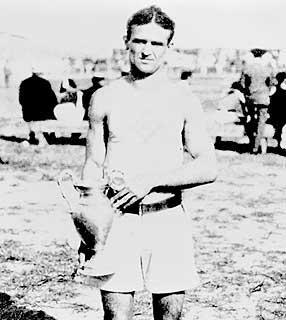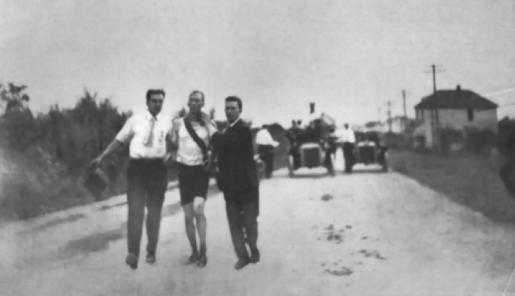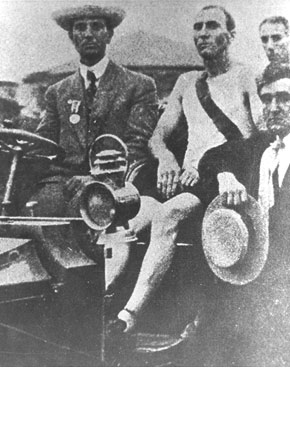Did the Original Winner of the 1904 Olympic Marathon Get a Ride in a Car During the Race?
Here is the latest in a series of examinations into urban legends about the Olympics and Olympians and whether they are true or false. Click here to view an archive of the Olympic urban legends featured so far.
OLYMPIC URBAN LEGEND: Of the first two finishers of the 1904 Olympic Marathon, one nearly died due to taking drugs designed to help him win the competition – and that’s the one who DIDN’T get disqualified.
In a sports world that has seen one Olympic skater attempt to have another skater (from her own country) crippled before the Olympics and seen countless star athletes revealed to have used some form of performance-enhancing drugs (like steroids), I suppose the events of the 1904 Olympic Marathon would not be that surprising. However, the sheer amount of scandal packed into one race is still quite notable, and one can only imagine the attention such a race would have received in the modern age of the 24 hour news cycle.
Of the first two men to cross the finish line in the 1904 Marathon, Thomas Hicks nearly died from using his era’s equivalent of “performance-enhancing drugs,” and he was the one who WASN’T disqualified. Fred Lorz’s journey to the finish line was even stranger than that, as it involved getting a ride in a car!
To say that the conditions for the 1904 marathon in St. Louis were not ideal would be severely understating the situation. The terrain on that late August day involved a muddy course and a series of about eight hills for the 40 kilometer race (not to mention the amount of motor cars kicking up worlds of dust and pollution as the runners raced). As inhospitable as the terrain was, the most dangerous aspect of the race was the heat. The race began at 3pm with the weather nearing 90 degrees Fahrenheit and the sun burning down on the contestants (I have read conflicting reports on the humidity- I lean towards believing those that said that the humidity was not that bad that day). Adding to the heat factor was the fact that hydration for all racers were only available at the 6 mile marker and the 12 mile marker – if a racer were to get other hydration, he would have to receive it from someone outside of the race. Unsurprisingly, then, the racer who ended up taking the race had a considerable amount of assistance from the sidelines (of course, what was seen as assistance at the time nearly killed the man!).
Of the 32 runners who started the race, a shocking eighteen failed to finish it!
One of the men who failed to finish, William Garcia of California, was nearly the first Olympic casualty! He had swallowed so much dust kicked up from the automobiles passing by that his esophagus was lined with dust and his stomach was hemorrhaging from all the dust that had entered it! It seems pretty clear that had it not been for the automobiles passing by, this race would have ended a lot sooner than it ended up finishing (and with a lot more runners finishing).
Due to the sheer amount of runners who failed to finish, an eccentric runner, Felix Carbajal, finished fourth in the race even after taking a BREAK during the middle of the race! Carbajal, a Cuban, had traveled a great distance to compete in the St. Louis Olympics, begging for money along the way to make it to Missouri. He raced in his regular street clothes (some friends cut his pants so that he at least could run in an approximation of shorts), as that was all that he had brought with him. He had not eaten in nearly two days, so when he saw an opportunity to grab some fruit along the way, he did so. He was leading the race at the time, but he developed severe stomach cramps from the food and had to take a break from the race. Still, due to the problems developed by the other racers, he still managed to recover in time to finish fourth.
Another racer, Len Tau of South Africa, was actually chased by a dog!!! In his attempt to avoid the dog, Tau ended up running an entire mile off course! He amazingly still came in ninth (like I said, this was a hard race for everyone).
The dehydration problem was what led to John Lorz quitting the race about 9 miles in. He could go no further. He rode in a car to meet the other racers at the finish line. However, after about 19 miles, the car he was in broke down. Lorz had recovered by this point, so he figured it would be a good laugh to re-enter the race. He did so at the 19 mile mark and quickly passed the leader at the time, Thomas Hicks. Lorz crossed the finish line 3 hours and thirteen minutes after the race had begun. Lorz treated it as a joke the entire time (although, admittedly, he did go along with the adulation, he just did not claim that he had won or deny what he had done), right up until when First Lady Alice Roosevelt (daughter of Theodore Roosevelt) tried to present him with a floral wreath! By this time, outraged Olympic officials had figured out that Lorz had not finished the entire race (something Lorz freely admitted when asked) and disqualified him.

How Lorz was handled following the race was interesting. James Sullivan, the head of the 1904 Olympics, was so outraged that he had Lorz banned from amateur athletic competition for LIFE! Luckily for Lorz, a few months later, cooler heads prevailed and it was agreed that Lorz legitimately was joking (he had a reputation as a prankster, which certainly helped him in this regard) and not actually trying to cheat. This worked out quite well for Lorz, as he would go on to win the 1905 Boston Marathon!
So this left the winner, Thomas Hicks, born in England but racing for the United States (only the second Olympian to win a medal for a country other than the one they were born in). Hicks got off to a good start, but by the 17th mile, he was pretty much just walking (luckily for him, so was everyone else). As opposed to the other runners, though, Hicks had some help on the sidelines, in the persons of his “support crew,” Hugh McGrath and Charles Lucas. At roughly the 19th mile marker (maybe a bit earlier), Lucas and McGrath administered 1/60 grain of sulphate of strychnine within a raw egg (as strychnine is incredibly bitter to eat on its own). Can you even imagine eating raw eggs on the 19th mile of a marathon in 90 degree heat, with the sun burning down on you? Strychnine, meanwhile, has been used as a rat poison for years, but it also DOES work as a stimulant for the central nervous system – so long as it is taken in small doses (it has ceased to be used for this purposes as, quite naturally enough, other medicines that were NOT poisons were developed to use as stimulants).
Soon after this, Lorz raced by Hicks and he was distraught, thinking he had lost the race. His handlers informed him that Lorz clearly was going to be disqualified, so they compelled Hicks to continue, as he had a good mile lead on the next runner. So they gave him another 1/60 grain of sulphate of strychnine along with two more eggs and some brandy (yes, drinking alcohol on a hot day while dehydrated in a marathon while also ingesting raw eggs and rat poison – some support crew Hicks had!).
Finally, Lucas and McGrath actually gave Hicks a warm sponge bath right there on the course. The last mile or so included a steep hill, but Hicks managed to get over it and while he attempted to jog down it, he couldn’t do much more than walk a little faster than normal. He finally crossed the finish line at 3 hours and 28 minutes – the longest finishing time in Olympic Marathon history (a dubious record that likely will never be broken). Hicks lost an astonishing TEN pounds on his race. He could barely move after the race and never competed in a marathon again. Another dose of strychnine quite literally might have killed him, so he was lucky he won when he did. There were attempts at protests over Hicks’ chemical aids, but James Sullivan ultimately turned them all down.
Here Hicks is with his “helpers”…

and here he being driven away after the race – look how awful his face looks! It’s like he is literally near death!

One last little curiosity occurred when Arthur Corey finished second at 3 hours and 34 minutes. Corey was a Frenchman, but since he did not have the right papers, he was listed as an American, which is what he is still officially listed as to this day.
The legend is…
STATUS: True
Thanks to Charles Lucas, who provided much of the details about the race in his memoirs from a century ago (it is interesting to read Lucas’ work, as he basically seems to have no problem with the idea that Hicks was not the most talented of the runners and that he won because of Lucas’ chemical assistance).
Feel free (heck, I implore you!) to write in with your suggestions for future installments! My e-mail address is bcronin@legendsrevealed.com.
Tags: 1904 Summer Olympics, Alice Roosevelt, Charles Lucas, John Lorz, Thomas Hicks





